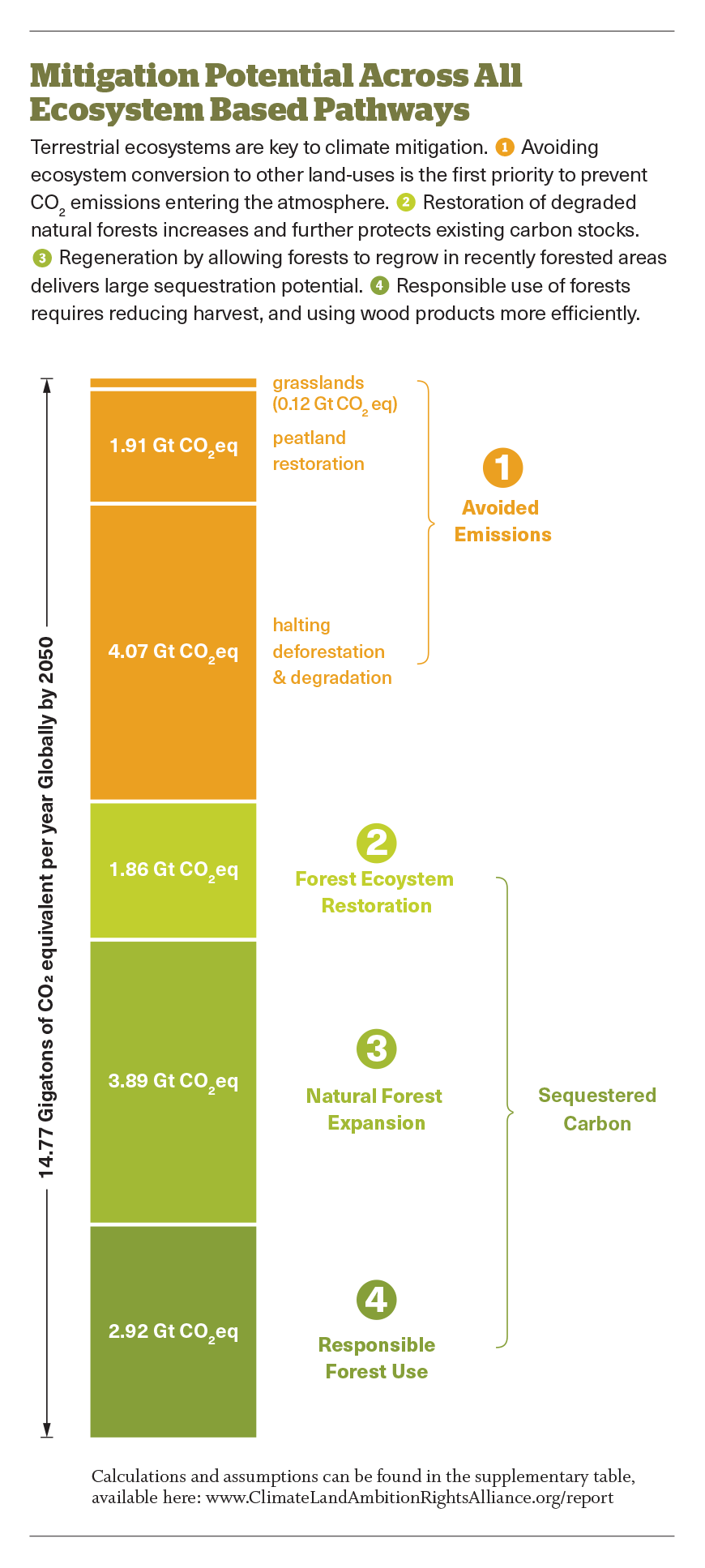Toward Real Zero
Missing Pathways—Rights-Based Solutions
In 2018, CLARA released the report Missing Pathways, which characterized a set of land-sector mitigation pathways grounded in concerns for rights and biodiversity. Emphasizing rights-based climate solutions that put the needs of people and planet first, especially the role that forests and improved agricultural practices can play, Missing Pathways proposed approaches to reaching quantified carbon sequestration goals to address the intertwined crises of climate change and global biodiversity loss.
CLARA welcomes the much greater recognition of the importance of the land sector for climate action since ‘Missing Pathways’ was published. There’s also been more attention to the importance of integrated climate-biodiversity solutions, as seen in outputs from the 2021 IPBES/IPCC Workshop, as well as the 2019 ‘Chile-Madrid’ UNFCCC decision, in which governments underlined the need to address biodiversity loss and climate change in an integrated manner. Contrary to this trend has been a strong push to define ‘nature-based solutions’ primarily in relation to the carbon content of these ecosystems.
Below we reproduce some of the key findings from ‘Missing Pathways’. One finding pertains to the irreplaceable importance of existing intact ecosystems. No amount of tree planting or even ecological restoration can compensate for any further loss of mature temperate or tropical forests. Recognition of indigenous and local land rights is an essential component of more sustainable management of intact ecosystems. Getting toward ‘real zero’ requires first that we examine ‘nature-based solutions’ for their impact on rights and livelihoods. It also requires us to safeguard true ambition, which is not found in offsets or ‘net zero’.
The remainder of ‘Missing Pathways’ focused on quantifying the carbon mitigation potential of the world’s forests in comparison to where we stand now; and pursuing dietary and land-use changes in agriculture to bring down the continued high emissions from food and fiber production.
First, in forests, CLARA compiled different restoration ‘wedges’ to estimate annual and total forest-restoration carbon sequestration and avoided-emissions potential. The first of these wedges is avoiding further loss and degradation of primary forests, as mentioned above.
The second wedge is restored forests—forests returned to a state of high ecological integrity [defined variously as ‘intact’, ‘pristine’, ‘undisturbed’, ‘old-growth’, ‘re-wild’ etc.]. Setting aside one-quarter of degraded natural forest cover globally (600 million hectares) would advance this goal, while helping preserve biodiversity and maintain ecological integrity. Successful restoration and subsequent protection of these forests in both these wedges would restore primary forest characteristics, increasing the area of primary forests to 50% of the global forest area.
The third wedge—for the other half of the global forest estate—is responsible use. Lengthening timber harvest rotation times and reducing harvest rates can produce significant increases in forest carbon stocks and biodiversity in temperate and boreal production forests. Commercial wood production should be sourced primarily from improved plantations. Wood production needs to be made more efficient, and wood utilization should move to longer-lived products. Any use of forest biomass for energy generation increases net carbon emissions over the next several decades and is thus incompatible with the sequestration goal. Use of forests for carbon offsets is not considered responsible use.
There are also wedges associated with grasslands and peatlands. We used the potential reported by Griscom et al for keeping grasslands intact, and also ‘avoided emissions’ associated with intact peatlands. Peatlands are extremely important, high-carbon ecosystems that contribute to a range of ecosystem services. But many have been drained in order to plant ‘deforestation commodities’ like oil palm, where they become net sources of GHG emissions.
Figure 1 illustrates these wedges and the mitigation potential associated with each.
FIGURE 1
FIGURE 2
Figure 2 summarizes agriculture sector emissions reductions from a projected baseline of 11 Gt CO2eq per year in 2050. Quantification of mitigation opportunities is most challenging for this sector. Whereas ‘sequestered carbon’ wedges are larger with respect to the forest estate, in agriculture the ‘avoided emissions’ are far more significant, and ‘avoided emissions’ come from changes in production practices as well as dietary change. Agroecological approaches and agroforestry will contribute to sequestering carbon; re-orienting food production and improving diets through agroecology will generate multiple significant benefits across avoided emissions, improved health, and revived food cultures. These values are generally not well represented in discussions of the climate response in agriculture.
The single largest ‘avoided emissions’ wedge in agriculture is found in dramatic reductions in the total volume of meat and dairy products consumed. Equitably reducing consumption, particularly of animal products, represents the single most effective climate intervention in the land sector.
The biggest climate benefit from avoiding production-related emissions comes from reducing reliance on synthetic nitrogen fertilizers. The production of synthetic nitrogen is energy intensive and inefficiencies of plant uptake mean that much of the synthetic nitrogen applied to crops is quickly turned to nitrous oxide, a potent greenhouse gas.
The major messages of the Missing Pathways report are even more relevant today than when first written. The emphasis on rights and biodiversity protection is challenged by a new market emphasis on carbon and offsetting mechanisms. In laying out rights-based pathways to true zero, CLARA in Missing Pathways emphasized that:
Land rights are key to ecosystem protection.
Deforestation must end, globally, not just on a ‘net’ basis but on an absolute basis.
Restoration, natural regeneration, reforestation, and improved forest management all represent important, separate opportunities for increasing mitigation ambition.
A focus on biodiversity and rights delivers greater mitigation ambition than only focusing on carbon. Adaptation in agriculture delivers substantial mitigation benefits as well.
Food production systems must be restructured toward agroecological approaches.
Climate-compatible food systems increase resilience, lessen the dependence on animal agriculture, while reducing hunger and ‘rich country’ diseases indicative of poor diet.



